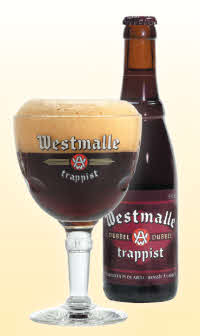Originally published in What’s Brewing November 2003
Origin: Malle, Antwerpen, Belgium
ABV: 7 per cent
Buy from supermarkets, specialist shops

Westmalle Dubbel
Westmalle abbey is a member of the beer world’s most exclusive club: the Trappist monasteries that brew beer commercially under the direction of the monks. There are currently only six of these, all in Belgium (a seventh, Koningshoeven in the Netherlands, is now run by secular brewers). All of them offer strong, distinctive, unpasteurised ales of exceptional quality, preserving a link to the monastic brewing tradition that played a vital role in the development of Europe’s beer culture.
It’s an extensive and rather forbidding red brick complex standing in dead flat countryside in the Kempen region, on the main road between Antwerp and Turnhout. Opportunities to visit are rare, but a tree-lined footpath circumnavigates the site and a roadside pub opposite serves the beer. After Chimay, the brewery’s products are the most widely marketed and distributed of the Trappist beers; unlike Chimay, they have not yet suffered accusations of falling quality.
Westmalle is also arguably the most influential of the Trappist brewers. Its pairing of a weaker, sweeter, brown “dubbel” with a stronger, dryer, spicier, golden “tripel” has since been copied far and wide by secular brewers of abbey-style beers. The names refer to the marks once made on beer casks to identify ascending strengths: an “enkel” (single), weaker still and actually known as Extra, is brewed almost exclusively for the monks’ own consumption.
The Tripel is venerated as a world classic, but I’ve always had a soft spot for the Dubbel. This also seems the most widely available in Britain, perhaps because of its lower strength. It’s brewed from German and French pilsner and dark malts, German and Czech hops, “natural groundwater”, the monastery’s house yeast and — characteristically for the style — a dash of candy sugar. The result, served with the yeast deposit if preferred, is a dark ruby brown beer with a soft, fawn coloured head, well exhibited in the traditional Trappist glass goblet.
The restrained aroma is malty and slightly curranty, leading to a rich and complex palate, soft-textured, mildly sweet and quite luxurious. Chocolatey malt and raisins dominate, with hints of banana and toffee and developing almondy hops. A yeasty tang emerges on the swallow, followed by an equally subtle and complex finish with mellow, nutty, powdery hops and a slight touch of spice over fruity and malty tones. All in all it’s a lovely mellow beer, approachable but elegant, and still very much the benchmark of its style.
Try also Affligem Postel Dobbel, Burton Bridge Tickle Brain, De Leckere Dubbel (Netherlands), St Feuillien Brune, Westvleteren Blauw
Read more at ratebeer.com: http://www.ratebeer.com/beer/westmalle-dubbel/2205/





Leave a Reply